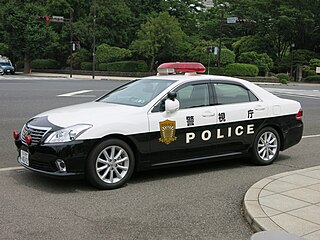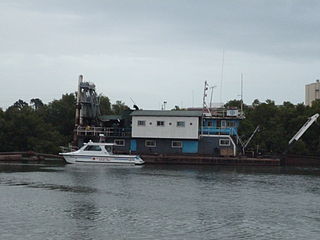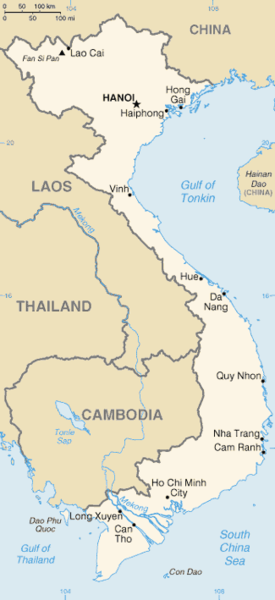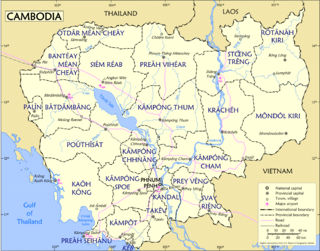
Crime in Cambodia is present in various forms.

Crime in Cambodia is present in various forms.
The rate of corruption in Cambodia is high; one source goes on to describe the situation as "nothing less than obscene". Corruption is considered a large expense to the Cambodian government. [1] The Cambodian police force is known to inappropriately use violence in certain cases. [2] The misuse of ferocity has raised concerns from the Human Rights Watch. [3] Petty crime is common, with tourist areas often targeted. This includes snatch theft and pick-pocketing. Perpetrators are usually stricken with poverty, and as a result are driven to steal from foreigners with the knowledge that they bring about a significant amount of money and other valuable items. Owing to the easy accessibility of arms, armed robbery also occurs.
Tens of thousands of Asians from different countries have been lured to casinos and resorts in Cambodia (but also Laos and Myanmar). These victimes would then be forced to work in illegal online-gambling or scamming outfits. These illegal operations are organised by ethnic-Chinese gangs that sometimes collaborate with local counterparts. [4]
In 2013, Cambodia had a homicide rate of 2.4 per 100,000 population. [7]
Prostitution is against the law in Cambodia, but still present and only growing. Le Thi Quy, a professor from the Women's Research Center, interviewed a handful of females in 1993 about prostitution; three quarters of the interviewees found being a prostitute to be a norm and a profession they felt was not shameful having. [8] That same year, the professor estimated that there were some one hundred thousand sex workers in the country. [8]
Petty crime is common, with tourist areas often targeted. This includes snatch theft and pick-pocketing. Perpetrators are usually stricken with poverty, and as a result are driven to steal from foreigners with the knowledge that they bring about a significant amount of money and other valuable items. Owing to the easy accessibility of arms, armed robbery also occurs. [9]
Cambodian citizens, primarily women and girls, have been sex trafficked within the country and throughout the world. [10] They are threatened and forced into prostitution, marriages, and or pregnancies. [11]
In 2008, the national survey showed that over one quarter of women in Cambodia suffered from domestic violence. [12] A 2013 UN report showed that 1 in 5 men in Cambodia between the ages of 18 and 49 had admitted that they had raped a woman. [13] 15.8% of those who admitted to having committed a rape had done so when they were younger than 15 years old. [13] “Bauk” is the term used in Cambodia for gang rape. [13] More than double the men in Cambodia admitted to gang rape in comparison to India. [14]
In scholarly literature and criminology, gang rape, also called serial gang rape, party rape, group rape, or multiple perpetrator rape, is the rape of a single victim by two or more violators. Gang rapes are forged on shared identity, religion, ethnic group, or race. There are multiple motives for serial gang rapes, such as for sexual entitlement, asserting sexual prowess, war, punishment, and, in up to 30% of cases, for targeting racial minorities, religious minorities, or ethnic groups.

Crime in Japan has been recorded since at least the 1800s, and has varied over time.

Violence against women (VAW), also known as gender-based violence and sexual and gender-based violence (SGBV), is violent acts primarily or exclusively committed by men or boys against women or girls. Such violence is often considered a form of hate crime, committed against women or girls specifically because they are female, and can take many forms.
Rape can be categorized in different ways: for example, by reference to the situation in which it occurs, by the identity or characteristics of the victim, and by the identity or characteristics of the perpetrator. These categories are referred to as types of rape. The types described below are not mutually exclusive: a given rape can fit into multiple categories, by for example being both a prison rape and a gang rape, or both a custodial rape and the rape of a child.
Statistics on rape and other acts of sexual assault are commonly available in industrialized countries, and have become better documented throughout the world. Inconsistent definitions of rape, different rates of reporting, recording, prosecution and conviction for rape can create controversial statistical disparities, and lead to accusations that many rape statistics are unreliable or misleading.

Crime and violence affect the lives of millions of people in Latin America. Some consider social inequality to be a major contributing factor to levels of violence in Latin America, where the state fails to prevent crime and organized crime takes over State control in areas where the State is unable to assist the society such as in impoverished communities. In the years following the transitions from authoritarianism to democracy, crime and violence have become major problems in Latin America. The region experienced more than 2.5 million murders between 2000 and 2017. Several studies indicated the existence of an epidemic in the region; the Pan American Health Organization called violence in Latin America "the social pandemic of the 20th century." Apart from the direct human cost, the rise in crime and violence has imposed significant social costs and has made much more difficult the processes of economic and social development, democratic consolidation and regional integration in the Americas.
Rape in the Philippines is considered a criminal offense. In Philippine jurisprudence, it is a heinous crime punishable by reclusión perpetua when committed against women. Rape of males is also legally recognized as rape by sexual assault, which is penalized by imprisonment of six to twelve years.
Violence against prostitutes include violent and harmful acts, both physical or psychological, against individuals engaging in prostitution. It occurs worldwide, with the victims of such acts of violence being predominantly women. In extreme cases, violent acts have led to their murder while in their workplace.
Crime in Haiti is investigated by the Haitian police. Since the late 2010s, the country has suffered from widespread gang warfare and civil unrest, including a massive prison breakout in 2024. It also suffers from extreme corruption and high levels of sexual violence.
Prostitution in Cambodia is illegal, but prevalent. A 2008 Cambodian Law on Suppression of Human Trafficking and Sexual Exploitation has proven controversial, with international concerns regarding human rights abuses resulting from it, such as outlined in the 2010 Human Rights Watch report.
Rates of crime in Guatemala are very high. An average of 101 murders per week were reported in 2018. The countries with the highest crime and violence rates in Central America are El Salvador and Honduras. In the 1990s Guatemala had four cities feature in Latin America's top ten cities by murder rate: Escuintla, Izabal (127), Santa Rosa Cuilapa (111) and Guatemala City (101). According to New Yorker magazine, in 2009, "fewer civilians were reported killed in the war zone of Iraq than were shot, stabbed, or beaten to death in Guatemala," and 97% of homicides "remain unsolved." Much of the violent nature of Guatemalan society stems back to a 36-year-long civil war However, not only has violence maintained its presence in the post-war context of the country following the Guatemalan Civil War, but it has extended to broader social and economic forms of violence.

Crime is present in various forms in the Philippines, and remains a serious issue throughout the country. Illegal drug trade, human trafficking, arms trafficking, murder, corruption and domestic violence remain significant concerns.

Crime is present in various forms in Indonesia and is punished by means such as the death penalty, fines and/or imprisonment, but is low compared to other nations in the region. Indonesia's murder rate of 0.4 per 100,000 registered in 2017 is considered one of the lowest in the world.
Crime is present in various forms in Myanmar and is continuous with the activities of many drug trafficking financed militias at the eastern and western border regions, and with corruption within and challenges to the central government.

Crime is present in various forms in Laos.
Violence against women in Cambodia is a serious issue. Cambodia has had a history of violence against women especially due to its past conflicts. During the Pol Pot regime, women were exposed to several different violent acts against them such as forced marriages and rape by the Khmer Rouge officials in Cambodia and refugee camps in Thailand. Presently, there is still a number of different forms of exploitation and discrimination against women in Cambodia such as rape, domestic violence, and human trafficking as the country is recovering from the history of conflict.

Crime in the Democratic Republic of the Congo is investigated by the DRC's police.

Sex trafficking in Vietnam is human trafficking for the purpose of sexual exploitation and slavery that occurs in the Socialist Republic of Vietnam. Vietnam is a source and, to a lesser extent, destination country for sexually trafficked persons.
Sex trafficking in Laos is human trafficking for the purpose of sexual exploitation and slavery that occurs in the Lao People's Democratic Republic. Laos is primarily an origin country for sexually trafficked persons.

Sex trafficking in Cambodia is human trafficking for the purpose of sexual exploitation and slavery that occurs in the Kingdom of Cambodia. Cambodia is a country of origin, destination and transit for sex trafficked persons.